|
National Arboretum, March 25, 2001
The following was transcribed from a talk given by George "Pat" Ring and Jane
Goodrich at the March 2001 meeting of the Potomac Valley Chapter of the American
Rhododendron Society.
Speaker: George Ring III:
- Past President and Vice President of the American Rhododendron Society,Past
President and Vice President of the Potomac Valley Chapter ARS, Chairman of the Gable Study Committee, Chairman of the ARS Long Range Planning Committee,
Recipient of both the ARS Bronze and Silver Medals
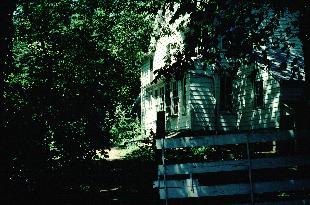 About 2000 years ago all roads led to Rome, the hub of the Roman Empire. In the fifty
years between 1920 and 1980 all roads for rhododendron people led to Joseph
Gable's home in Stewartstown, Pa. Not many people used that road for quite
a
long time because they didn't know about Mr Gable. The road led not to a
commercial nursery but to a small farm where this lone man grew species and
hybridized rhododendrons and azaleas the like of which had never been seen on
the East Coast. He had learned early on that most species available were not
hardy in Pennsylvania. His goal was to grow hardier plants and he very much
succeeded . As his biographer said,"Joe Gable made hybridizing seem
deceptively simple." It wasn't as simple as he made it look. Other people
tried and had trouble producing the quality of plants he did. One was George
Miller. He said he developed a real appreciation of Joe Gable's work when
he
tried to extend it.
About 2000 years ago all roads led to Rome, the hub of the Roman Empire. In the fifty
years between 1920 and 1980 all roads for rhododendron people led to Joseph
Gable's home in Stewartstown, Pa. Not many people used that road for quite
a
long time because they didn't know about Mr Gable. The road led not to a
commercial nursery but to a small farm where this lone man grew species and
hybridized rhododendrons and azaleas the like of which had never been seen on
the East Coast. He had learned early on that most species available were not
hardy in Pennsylvania. His goal was to grow hardier plants and he very much
succeeded . As his biographer said,"Joe Gable made hybridizing seem
deceptively simple." It wasn't as simple as he made it look. Other people
tried and had trouble producing the quality of plants he did. One was George
Miller. He said he developed a real appreciation of Joe Gable's work when
he
tried to extend it.
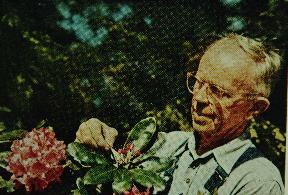 To our good fortune, Joe Gable gradually evolved from being a full-time
farmer to a part-time nurseryman. And then to a full-time nurseryman. He
corresponded and traded seeds and pollen with rhododendron people throughout
the U.S., Canada, and Europe, including George Fraser and James Barto on the
West Coast, and E.J.P. Magor and the Rothschilds in England. Dr. Sargent at
the Arnold Arboretum provided Joe with information on plant identification,
seeds, and further contacts. Gable also subscribed to several plant
expeditions to China which provided seeds for his many trials of species. His
wife, Mary, was not aware of this, as money was very scarce in those days.
At one time he was growing more than 50 species rhododendrons.
To our good fortune, Joe Gable gradually evolved from being a full-time
farmer to a part-time nurseryman. And then to a full-time nurseryman. He
corresponded and traded seeds and pollen with rhododendron people throughout
the U.S., Canada, and Europe, including George Fraser and James Barto on the
West Coast, and E.J.P. Magor and the Rothschilds in England. Dr. Sargent at
the Arnold Arboretum provided Joe with information on plant identification,
seeds, and further contacts. Gable also subscribed to several plant
expeditions to China which provided seeds for his many trials of species. His
wife, Mary, was not aware of this, as money was very scarce in those days.
At one time he was growing more than 50 species rhododendrons.
The people who knew about the Gable place in the early days were just
a few like the DuPonts, the National Park Service who obtained rhododendrons
for around the White House and other Park grounds, and a few hybridizers,
such as Guy Nearing with whom he shared seeds, Tony Shammarello, Lanny
Pride, and Capt. Dick Steele of Nova Scotia. Capt. Steele gave a talk to the
Potomac Valley Chapter about 25 years ago. It renewed our interest and made
us realize how great Joe Gable's plants were.
In 1954 there was an article in the Saturday Evening Post called "The
Flowering Forest of Joseph Gable", and many people learned about Joe Gable,
and that includes me. Indeed, as a result of this article many people made
annul "pilgrimages" to Stewartstown. A visit with Joe was always educational
because he shared his knowledge, and it was rewarding, too, because you could
get small plants of his best hybrids. Mary, his wife, often treated us to
lunch with homemade apple pie.
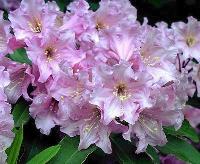 On one of my first trips I set out with a goal of obtaining a Cadis,
which is a hybrid of Caroline x discolor.It is fragrant and an outstanding
grower. At the time I had only $10 to buy one. Joe said he didn't have any
small ones, but he would let me have one that he had used to make cuttings.
It happened to be a 4 foot stick with few leaves left on it. I decided to
take it and brought it home to much derision. But that stick grew into one of
the prettiest plants I grew in Fairfax. It changes color a bit with the
weather.
On one of my first trips I set out with a goal of obtaining a Cadis,
which is a hybrid of Caroline x discolor.It is fragrant and an outstanding
grower. At the time I had only $10 to buy one. Joe said he didn't have any
small ones, but he would let me have one that he had used to make cuttings.
It happened to be a 4 foot stick with few leaves left on it. I decided to
take it and brought it home to much derision. But that stick grew into one of
the prettiest plants I grew in Fairfax. It changes color a bit with the
weather.
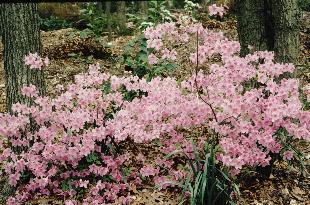 On the same trip told Mr. Gable that I would like a Big Joe azalea. He
said "I'm sorry we don't have any Big Joes; we only have Little Joes,"
which were not much more than rooted cuttings at the time. The cross is
poukhanense x kaempferi. It is a great grower and comes out early in the
spring.
On the same trip told Mr. Gable that I would like a Big Joe azalea. He
said "I'm sorry we don't have any Big Joes; we only have Little Joes,"
which were not much more than rooted cuttings at the time. The cross is
poukhanense x kaempferi. It is a great grower and comes out early in the
spring.
It is important to note that Joe Gable developed a wide range of
rhododendrons and azaleas, mostly using hardy species such as brachycarpum,
maximum, catawbiense, and smirnowii for the broadleaf sorts. In azaleas he
used the hardy poukhanense and kaempferi which were obtained from the Arnold
Arboretum. His seedlings were eventually planted in the woods back of his
home where the hardy ones survived drought, cold and summer heat, year after
year. This survivability makes his hybrids highly desirable today.
It should be noted that in his later years Henry Yates of Frostburg,
Maryland, helped Joe make some of his later crosses, especially using Mars.
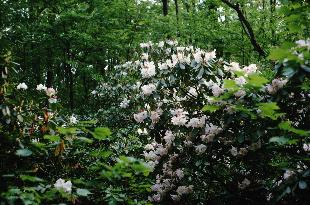 Mr. Gable lived until 1972. Many of his seedlings matured after that date
and have since been evaluated by his daughter the late Caroline Gable.
Helpers with this were Ray and Jane Goodrich of Fairfax. They helped
Caroline sort out the row records of Joe's with the plants in the woods,
and
identified many of the plants. Jane Goodrich is a place to start if you want
to know more the Gable plants. An excellent place to learn is the Gable
chapter in "Hybrids and Hybridizers".
Mr. Gable lived until 1972. Many of his seedlings matured after that date
and have since been evaluated by his daughter the late Caroline Gable.
Helpers with this were Ray and Jane Goodrich of Fairfax. They helped
Caroline sort out the row records of Joe's with the plants in the woods,
and
identified many of the plants. Jane Goodrich is a place to start if you want
to know more the Gable plants. An excellent place to learn is the Gable
chapter in "Hybrids and Hybridizers".
To illustrate the wide range of plants that Joe Gable developed, I will
show a series of slides.
This concludes my presentation. I hope it has given you an idea of the
diversity of the plants that Mr. Gable developed. What my presentation
cannot show is the growability and hardiness of these plants compared to
others. Some are available from commercial nurseries. Others could be made
available if the Chapter undertook a distribution project, and I recommend
that this be done.
Speaker: Jane Goodrich: -
Secretary of the Gable Study Committee, Past Secretary of the Potomac Valley Chapter
ARS, Recipient of the ARS Bronze Medal
Part of what I have to say will be controversial. You've already heard the
good stuff from George.
My gardening philosophy is simple: if it's not a rhododendron, it's weed.
And the second part is:if it's not a Gable, it could be a bit suspect.,
Anyway, these are my favorites:
-
Mary K -Which is Catalgla x fortunei, 2 hardy parents. The fortunei was
bred for 7 generations by Gable and Nearing. I has promise as a good parent.
Mary K sport. The cutting of this didn't take, but George Miller put the
pollen on Gable's auriculatum-discolor F2, and I have seedlings of this
cross,. It put in some back bone.
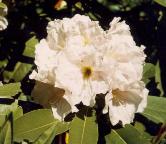
- Disca- All the books say it is discolor x Caroline. Years ago we ordered
a discolor from Gable's, and the letter came back: we prefer Disca as a
better from of discolor. Always the Doubting Thomas, I selfed Disca, and lo
and behold, Caroline did not appear in any of the progeny. Some were tender
and one was a bit hardier than Disca, but all were discolor.
- Mt. Siga and Kulu- These are seedlings of Joseph Rock's collecting in
China in the 1920s . They were know at one time as R.18139 #1 and R.18139 #2.
Joe Gable waited years to see them bloom, and he wrote that it was worth
the wait. He always referred to them as vernicosum, aff. Affinis, meaning
like vernicosum.
The Salley cd-rom says they are half vernicosum. No way! Some years ago
we sent pollen of our first 18139, later to be named Kulu, to George Miller
for him to put on his 18139. What we didn't know was that his was a Kulu
too. We could have made the cross in our own back yard. When the seedlings
bloomed they were uniform, as were those we had taken to Caroline, who
pronounced hers uniform, the real thing. So there seems to be a question of
identity. If you want to sib the two, Mt. Siga and Kulu, it'll take 11 years,
but it took Gable , so we shaved it a bit.
- Dr. Rock- houlstoni x vernicosum, aff. R.18139 . Also known as 1964 because it was the best of the newly blooming plants of that year. It may be
hardier than its parents.
- Decorum (so-called) from Gable's woods. George Ring, Caroline,Ray and I were out in Gable's woods one spring. George came up with a floret in his hand: it had red stylar glands. Guess what: that made it a vernicosum. This,
I
believe, is the "hardy decorum" that many in Pennsylvania have. You will
find a reference to it in "Hybrids and Hybridizers", although the numbers are
transposed. It is Rock 6829, I came from the 1924 Rock expedition. Talk
about longevity.
I would like to read part of an e-mail from Dick Steele, who knows more
about Gable plants than any one except maybe George Ring. He is talking about
Gable plants in cold Nova Scotia."The deer are doing us great damage and the
following are some of the plants(Gables) that they have avoided: Big Cat
Mar, Best Cat Mar, Sunrise 76, Smirfort, Caroline Cream, 6-70, Peaches,
Double Dip, Albert Close, red sib of Albert Close, and Frasers Red. "
Some of these should be available as cuttings at the Chapter July auction.
-
Note: The members of the Potomac Valley Chapter of the American
Rhododendron Society are indeed thankful to both George Ring and Jane Goodrich
for providing us with such an excellent accounting of the
Rhododenron
Legacy of Joe Gable. Our chapter has decided to begin a "Plants for Members"
program where we intend to propagate cuttings of the Gable hybrids and
reintroduce them into the community. We have also planned to add to the
collection of Gable hybrids at the
Margaret K. and John C. White Horticultural
Center, a recent contribution to the Fairfax County Park Authority.
|





